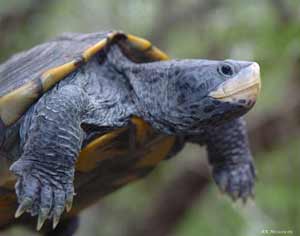Abstract of Paper
Presented by Wetlands Institute staff at the
All Florida Herpetology Conference, March 26–27, 2005, Gainesville, Florida
Mangrove Terrapins (Malaclemys terrapin rhizophorarum) in the Florida Keys
Benjamin K. Atkinson1 and Roger C. Wood 1, 2
![]()
1The Wetlands Institute, 1075 Stone Harbor Boulevard, Stone Harbor, NJ, 08247
2 Richard Stockton College of NJ, PO Box 195, Pomona, NJ 08240
benjaminkatkinson@yahoo.com; roger@wetlandsinstitute.org
![]()
|
Mangrove terrapins (Malaclemys terrapin rhizophorarum) were first described by H.W. Fowler in 1906 on the basis of a single adult female discovered on the island of Boca Grande (now part of Key West National Wildlife Refuge) in the southwesternmost Florida Keys. No further scientific studies were undertaken until the early 1980s, when a comprehensive survey of islands in the lower Florida Keys provided the first reliable information about the distribution and abundance of mangrove terrapins in the area. Hundreds of terrapins were marked during the surveys of the early 1980s, especially at the eastern end of Barracouta Key, which supported the densest population in the lower Keys. Intermittent fieldwork has since continued on a very irregular basis. The region took a direct hit by Hurricane George in 1998, and subsequent brief surveys indicate that the population may have been substantially reduced. In early 2005 a team from the Wetlands Institute returned to the lower Keys to revisit all of the islands where populations had previously been discovered. The purpose was to investigate two questions: (1) has the population of mangrove terrapins in the lower Keys been significantly altered since the early 1980s; and (2) could marked individuals from the early 1980s be recovered, thus establishing (potentially) the best longevity data for any population of diamondback terrapins rangewide? The results of this survey work will be used in conjunction with longevity data for terrapins currently being developed at the Wetlands Institute on the basis of skeletochronology.
